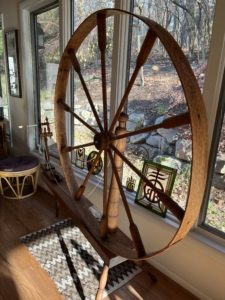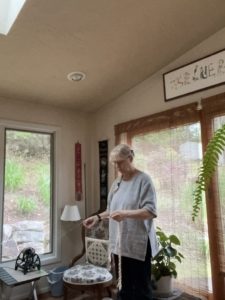The title sounds like something the “Spinning Police” would say, doesn’t it? No, I’m not here to give you a ticket, but maybe an idea instead.
Have you ever thought about spinning while standing up? After all, unlike with a treadle wheel, an electric wheel will operate without your feet and without the need to be close to the orifice. Hmmm, isn’t that what people did with a Great Wheel, back in the day?
According to Dr. Michael Greger, author of How Not To Diet, “Standing burns three times more calories per minute than sitting. Even if you’re standing still, your postural muscles are extended and stretched to fight gravity, so anything you usually do while sitting, try doing while standing.”
That sounds like something I can get behind, and perhaps you can, too. A lot of spinners feel obligated to sit because that’s what we learned to do at a treadle wheel.
The theory behind using a standing desk and a treadmill to increase our movement throughout the day is the same. I can envision finding a table to set my e-spinner on near a treadmill and getting steps in while spinning. Seems decadent somehow.
Actually, while writing this, I cleaned off my long-neglected Great Wheel and decided I would give her another chance to help me get some steps in. I’m even considering creating a workout for my watch that’s for spinning, though I may have to give it a slightly different name because I’m fairly certain it won’t be as strenuous as spinning on a bicycle at the gym.
Let me say by way of a disclaimer that I am not a healthcare professional nor do I have any knowledge about whether you should try these things. I merely offer them as a possibility if it’s suitable for you.
Here’s a few things I picked up while experimenting with this. It’s a little challenging in the beginning, and there are some things you’ll probably want to consider regarding twist and drafting style.
You’ll want to adjust the speed of your e-spinner, the distance you stand from the orifice, and your general spinning mechanics. In the Place issue (Summer 2023) of PLY Magazine, Jacey discussed where to take plyback samples. This will be particularly helpful as you change your usual spinning position. Once you decide where you’re going to stand, you probably will need to know how much twist your e-spinner is putting in at all of the three places Jacey suggests:
1) where the single bends for the last time before winding on
2) where the single enters the orifice
3) some convenient (repeatable) place near the drafting zone
Though I tend to favor a supported longdraw (woolen with twist between my hands) because my fiber of choice is usually cotton, I can see no reason why a worsted draft (no twist between your hands) will work. You will need to experiment and make the adjustments that will help you know how to make the yarn you want regardless of whether you’re standing or sitting. This is one of those instances where there is no right or wrong answer and your mileage may vary.
One thing I also like about standing while spinning is that I can shift my weight from foot to foot which helps keep my muscles more pliable. (Ouch, did I really say that?)
Give this a try and see what you think.
 Liza Jennings Seiner has been a spinner for over 10 years having asked the question: “Where does yarn come from?” She lives in Southwestern Pennsylvania and blogs at summerhillspinner.wordpress.com. She has an Etsy shop and can be found on social media as Summerhill Spinner.
Liza Jennings Seiner has been a spinner for over 10 years having asked the question: “Where does yarn come from?” She lives in Southwestern Pennsylvania and blogs at summerhillspinner.wordpress.com. She has an Etsy shop and can be found on social media as Summerhill Spinner.





Leave a Reply
Want to join the discussion?Feel free to contribute!